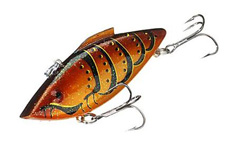
Anglers have long known the importance of shad in the diet of gamefish such as bass and stripers. But for a long time nothing on the lure market had quite captured the exact shape and sound of a shad and its tight swimming pattern. Bill Lewis changed all that when he built the first lipless crankbait and started building them in a small shop in Boyce, Louisiana, in the late 1960s and early 1970s.
 |
| Today, the Bill Lewis Rat-L-Trap is still made by hand in Alexandria, Louisiana. |
With its shimmying, tight wiggle and built-in rattle chamber that created noise and chatter, the Rat-L-Trap was an instant success as a fish-catcher. A bomber pilot during World War II, Lewis hit the road to market his new invention, selling them out of the trunk of his car. Marinas on Toledo Bend and several other east Texas lakes proved fertile testing grounds. In short order the lure became one of the hottest on the bass fishing scene.
As they were transplanted to more and more waters, freshwater stripers also became another prime target for the Rat-L-Trap. Soon inshore saltwater anglers were throwing the "Trap" as well and scoring terrific catches on redfish, trout and other species. But bass were and always will be the main quarry the lipless crankbaits or "vibrators" are thrown at.
When he outgrew his original facility, Lewis moved the plant to nearby Alexandria, Louisiana, where the lures are still built by hand today; little changed except for component upgrades since the day he invented it.
As testimony to the effectiveness of the Rat-L-Trap, virtually all large lure manufacturers make their version of the lipless crankbait. Many are superb fish-catchers, but the original is still preferred by countless casual fishermen and pros alike. And the idea of a rattle inside the lure has spread to other types of artificials, including topwater plugs, jigs, fat crankbaits, spinnerbaits and even worms.
Tactics
Rat-L-Traps are great for searching for fish and exploring new waters. The reason is that they work well when retrieved fast, allowing you to cover ground quickly. Probe flats, points, grassy shoreline edges, coves, fallen logs, vegetation, offshore humps and riprap along roads and bridges. Cast out and crank the lure back anywhere from moderate to fast, with no pauses.
In deep water try a different approach. Cast out and watch for strikes on the drop. Set the hook at the slightest sideways movement of the line or "tap." When the lure hits bottom, reel a few feet and then pause. Reel again and then pause.
For suspended fish, vertical jigging with these lures is productive. Lower the offering to the structure or where you've located fish on the depth finder, then raise it up and lower it back down in 12- to 36-inch movements of the rod. Watch for strikes as the lure flutters back down on the drop.
If you're targeting fish surfacing on top, cast out and reel the lure steadily just below the surface. And hold on tight. Strikes on the Rat-L-Trap can rip the rod right out of your hand!
- 7236 views

